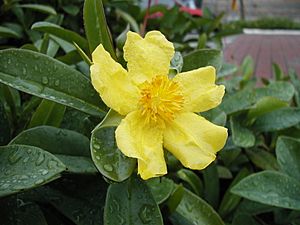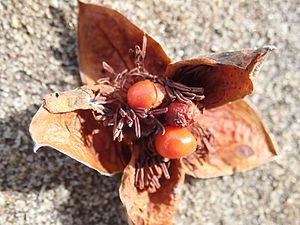Hibbertia scandens facts for kids
Hibbertia scandens, also known as the snake vine or golden guinea plant, is a beautiful flowering plant. It belongs to the Dilleniaceae family. This plant is originally from Australia. However, many people grow it in their gardens all over the world. It can grow up to 4 meters (about 13 feet) long. It is a climbing or sprawling evergreen shrub. This means it stays green all year round. It has shiny leaves and bright yellow flowers.
Quick facts for kids Hibbertia scandens |
|
|---|---|
 |
|
 |
|
| Fruit, Palm Beach, NSW | |
| Scientific classification | |
| Genus: |
Hibbertia
|
| Species: |
scandens
|
 |
|
| Collection data for H. scandens from the Australasian Virtual Herbarium | |
Contents
What Does the Snake Vine Look Like?
The snake vine has bright yellow flowers. Some people say these flowers have a strong smell. It might remind them of mothballs or even animal urine. The leaves are shaped like an oval or wider at the top. They are usually about 6 centimeters (2.4 inches) long.
The plant also grows fruits. These fruits have bright orange parts. Each orange part surrounds a black seed. Even though the fruit looks nice, it is not safe to eat. If you eat it, your mouth and lips might feel a burning sensation.
Plants growing near the ocean often have hairy leaves. Their leaves are shaped like a spoon. Their flowers usually have 6 or 7 small parts called carpels. Plants growing further inland tend to be smoother. Their flowers usually have 3 or 4 carpels.
How the Snake Vine Got Its Name
The scientific naming of plants is called taxonomy. In 1799, a German botanist named Carl Willdenow first described this species. He named it Dillenia scandens. The word scandens comes from Latin. It means "to climb," which makes sense for this climbing plant.
Later, in 1805, a Swedish botanist named Jonas Dryander moved the species. He placed it into the genus Hibbertia. That is why its full scientific name is now Hibbertia scandens.
Where Does the Snake Vine Grow?
The Hibbertia scandens plant naturally grows in Australia. You can find it from the southeastern part of New South Wales. It grows all the way up to the northeastern part of Queensland.
There are also records of this plant growing in New Zealand and New Guinea. These records come from the Australasian Virtual Herbarium. This is a large collection of plant information.
Growing the Snake Vine
Many people grow Hibbertia scandens in their gardens. It is a popular ornamental plant. This means it is grown for its beauty. It can grow well in many different places.
It can grow in areas with some shade. However, it will produce the most flowers if it gets full sun. This plant does not like very cold weather. It can only survive temperatures down to about 5 degrees Celsius (41 degrees Fahrenheit). So, in colder places, it needs protection in winter.
In the UK, this plant has received a special award. It got the Royal Horticultural Society’s Award of Garden Merit. This award means it is an excellent plant for gardens.

